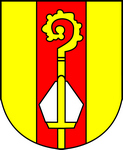History
Part of the City of Lugano since 2008, the district of Carabbia initially based its economy primarily on agriculture, while in recent decades it has experienced significant population growth.
In the 19th century, above the village, the Grotta del tesoro (Treasure Cave) was excavated in the hope of finding a silver vein.
The current name "Carabbia" probably derives from Carà (carriageway), while it is known that in the Middle Ages the noble Della Torre family of Mendrisio and the Torello convent (in Carona) owned land in "Carabio" (the name appears in documents dating back to 1270).
The coat of arms

The Armoriale dei Comuni ticinesi by Gastone Cambin, published in 1953 by the Istituto Araldico e Genealogico di Lugano, described the coat of arms of Carabbia as follows: "Or (gold), a pale gules (red) charged with a mitre argent (silver), adorned or (gold), and a crozier of the same."
The coat of arms alludes to the probable meaning of the name Carà (carriageway), which, along with the mitre and crozier, references Bishop Saint Syrus (San Siro) of Pavia, a martyr in 96 AD, to whom the church of Carabbia is dedicated. According to tradition, Saint Syrus passed through the area during his mission to evangelize Como and Raetia.
Places of interest
Located in the center of Carabbia since 2006, a sculpture by Swiss artist Rudolf Tschudin titled Net-Werk symbolizes the world and the network of private and public relationships. The structure has a diameter of 2.10 meters and weighs over 300 kilograms.
In the 19th century, the Treasure Cave (Grotta del tesoro or Grand tresor), a pyrite-bearing excavation, was dug on a steep slope of Monte San Salvatore. There is no evidence of actual gold traces, as its nature more likely results from water erosion over millennia.
The caves are five in number, varying in size, and have been the subject of geological studies. They consist mostly of small chamber-like cavities. The first cave is 14 meters long, with two low and elongated openings separated by a boulder about 20 meters wide. The second cave is 12 meters long, with a low and wide entrance. The third cave, 13 meters long, is accessed through a narrow passage that descends steeply into a low chamber and ends in a fissure. The fourth and fifth caves are only a few meters long.
Located in the historic center, in Piazza Balmelli, Casa Laurenti is a historic monument built by Colonel Cerutti and dating back to the 17th century. The building spans multiple levels and stands out for the beauty of its private terrace and the graffiti decorations around the windows. The doors are also finely crafted.
The Conventino is an elegant 18th-century building with a charming internal courtyard, located in the heart of the district. It is likely that its original function was to host groups of friars accompanying the Bishop of Como during his visits to the summer residences on the Arbostora. At the time, vineyards were cultivated, and there was also a farmhouse.
The English version of this page was created with the aid of automatic translation tools and may contain errors and omissions.
The original version is the page in Italian.